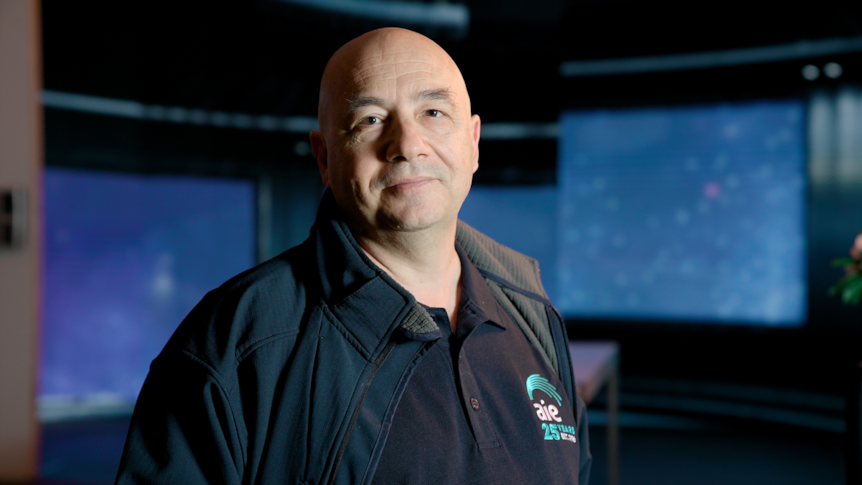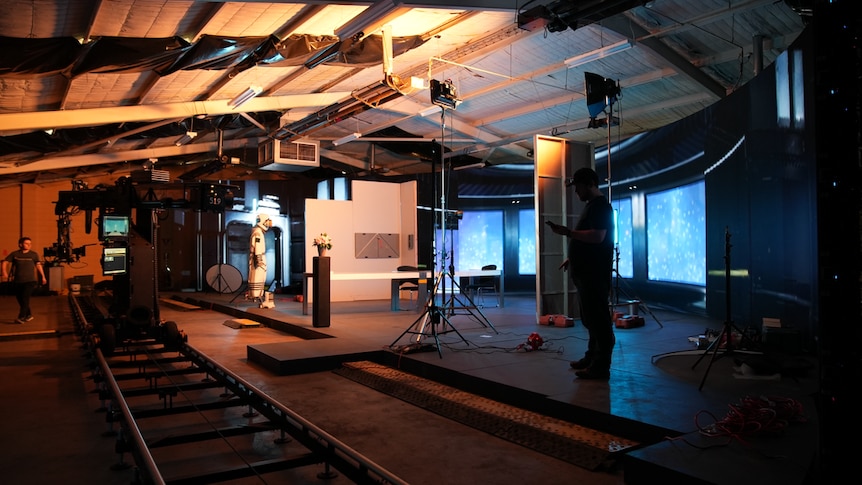Film students at the Academy of Interactive Education (AIE) in Canberra are now able to use technology seen on productions such as The Mandalorian and Thor: Love and Thunder.
Key points:
- The AIE’s StageCraft course is the first to exist in the world
- The technology displays backgrounds that move as the camera does
- Teacher Dan Sanguineti says the course focus is hands-on experience
The non-profit vocational education provider has begun offering a world first course using an immersive visual effects technology called StageCraft, an alternative to a green screen.
The virtual production technology, which is becoming increasingly common in high budget film production, allows filmmakers to create a virtual 3D space – much like that of a video game setting.
Actors perform on a real set with props, but their background is made in a gaming engine and displayed on curved screens.
The virtual setting can then be recorded in the background of shots, moving as the camera does, as though it were a real set.
Artificial intelligence (AI) is also used to capture the movement of the actors in a motion control environment.
‘Nothing on this level’
Maggie Callinan is the director of a student project at AIE, and one of the first students to try out the new technology.
“I’ve been doing personal projects, films and stuff since I was in early high school, but nothing on this level,” Ms Callinan said.
“It’s pretty cool, we have actual set bills and stuff. It’s like a low budget Hollywood [film].
“I’m grateful that I get to be able to use this stuff so that if I was to get a job in the industry later on, I can know what I’m doing.”
Her current project, Ace of Spades, is about two astronaut trainees that get bored on a spaceship and have a friendly but dramatic playing card battle.
She said using StageCraft made telling a story set in space much easier.
“We don’t have to build an entire set, we just have to project up the back plate and it’ll move with the camera,” she said.
“We just need a couple extra things – some tables, set dressing, stuff like that.”
Students learning ‘industry standard’ tech in the capital

Academy of Interactive Entertainment CEO John de Margheriti said the technology was becoming commonly used in the film industry, and was recently being used to shoot Thor: Love and Thunder in Sydney.
“The Mandalorian TV series that Disney has put together, and all the other TV series related to the Star Wars universe, all use this same technology,” he said.
“It’s widely used now, it’s industry standard almost, and what we’re doing is we’re training students to understand how to basically do movies that are [at a] really high production level.”
AIE has four campuses – in Melbourne, Sydney, Adelaide, and Canberra respectively – but their full virtual production technology is only in Canberra.
Mr Margheriti said they train students to use it on the other campuses so when they come to the capital for filming they know how it works.

“What we’ve done is we’ve created smaller volumes in the campuses in Sydney, Melbourne and Adelaide to allow students to experiment with the technology,” Mr Margheriti said.
“It’s only here that they actually see it in its full glory in a studio environment.”
Filmmaking and Virtual Production teacher, Dan Sanguineti, said when designing the course the focus was on giving students a chance to get hands-on experience with the professional equipment.
“We want the students to be able to make films that they had a chance to get their voice into, have the opportunity to touch equipment and make films that really matter to them,” he said.
“It’s not just about understanding or the theory, it’s really about having that opportunity to touch a camera, or to set a light, or to place a prop in the right spot and how that matters to story.”
















